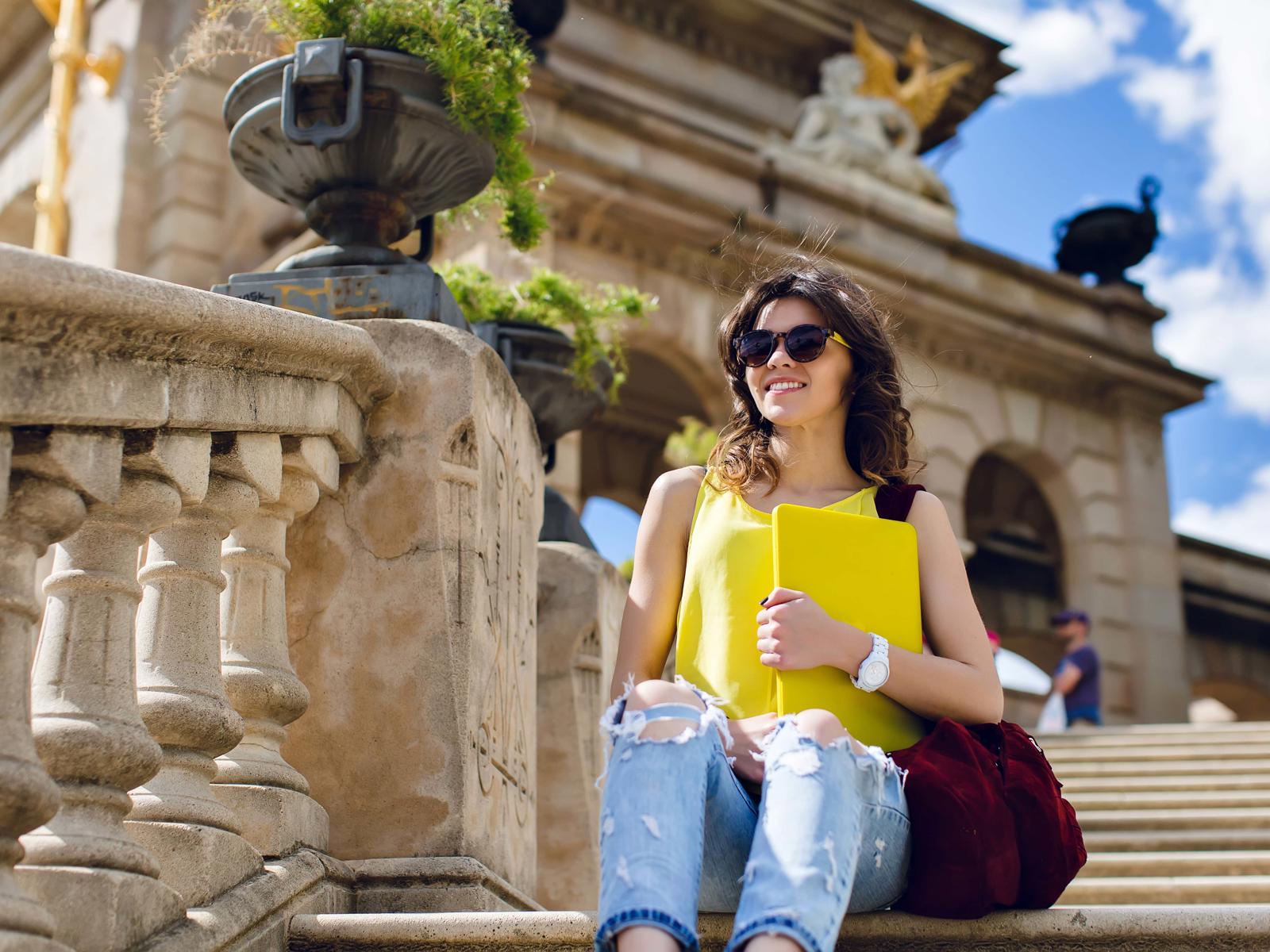Yes, English is the primary medium of instruction in Malta. Italian students need to improve their English skills to excel academically and socially.
Why is Malta the ideal study destination for Italian students?

Malta is a cultural melting pot where students feel right at home. It is home to around 21,808 Italian students, approximately 27.8% of international students studying in Malta.
Malta's proximity to Italy (just a 90-minute flight from Rome) and shared Mediterranean lifestyle make it a familiar yet refreshing study-abroad destination. From the warm hospitality of locals to the abundance of Italian restaurants and pizzerias, this country offers you a home away from home, enabling you to explore new horizons and write a tale of your career and success.
As a prep-up before landing in Malta, you can start brushing up your English skills. GBS Malta offers programmes that are taught in English. You can practice conversational phrases using apps such as Duolingo or Babbel and be sure not to hesitate to immerse yourself in English in the country.
Want to study in Malta!
Overcoming language barrier for students
For many Italian students, adapting to an English-speaking environment in Malta can be the first challenge. While English is one of Malta’s official languages, locals also speak Maltese, which can be interesting.
Real-life example:
Chiara, a student from Italy, pursuing an MA in business and management in Malta, joined a language exchange group in Valletta. Practising English and picking up some basic Maltese phrases will help you quickly feel more confident when interacting with peers and locals.
Solution:
Look for lingual workshops organised by student clubs and community centres. In addition to language exchange groups, try using language learning apps like Babbel or Duolingo, or consider enrolling in a short English course before arrival. Being proactive in improving your language skills will help you build confidence both in and out of the classroom.
You can also use apps like Meetup to connect with language groups and Tandem to dig into more opportunities to practice English with native speakers.
Student life in Malta: Adapting to ‘brand new' academic system
The academic environment in Malta is unique and follows a structure that differs from what students are used to in Italy. Educational institutions like GBS Malta, too, focus on practical, career-oriented education. With a curriculum that includes group projects, presentations, and internships, students learn through a realistic approach.
Key differences: Student life in Malta Vs. Italy
- Grading system: In Italy, the grading system for exams ranges from 0 to 30, with 18 being the passing grade. For final degree assessments, a scale of 0 to 110 is used. On the contrary, Malta uses the British grading system (an A-F grading scale), which is different from Italy. Make sure you familiarise yourself with how grades are awarded.
- Interactive learning: Unlike lecture-heavy classes in Italy, Maltese institutions encourage open discussions and practical knowledge. GBS Malta achieves this through an industry-relevant curriculum and qualified mentors who guide students on the right career path.
Practical advice:
Attend orientation programmes offered by your education partner. These programmes help you understand the academic structure and introduce you to the student community for peer support and learning guidance.
How to build a social network in Malta?
Moving to Malta doesn't mean leaving behind your Italian roots. You will find plenty of fellow Italians in Malta, forming a tight-knit community. However, you must connect with other students to grow and gain a better understanding of different ethnicities, cultures and traditions. Connect and make the most of your international experience during your student life in Malta.
Example:
Marco, a student from Italy studying in Malta, joined the Erasmus Student Network (ESN). He made friends from Spain, Germany, and Greece through their events and activities while staying connected to the Italian community.
Solution:
- Make a list of your interests and join student clubs and societies accordingly. Most institutions have organisations for international students. For example, GBS Malta students participated in the St. Paul's Bay community cleanup event and volunteered at the Island Sanctuary Malta.
- Another great idea would be to attend local festivals like Carnival in Malta and Birgu Fest. This is an opportunity to immerse in Maltese culture while meeting and mingling with the Italian community in Malta and locals.
Managing living expenses
Student life in Malta can be affordable, but planning and adhering to a budget is essential. As an Italian student, you will notice specific differences in the cost of living compared to cities like Milan or Rome.
Budget breakdown:
- Accommodation: Expect to pay around €300-€600 per month for shared apartments, depending on the area. Living costs are generally lower than in major Italian cities like Milan or Rome.
- Food: Though you can choose to indulge and eat at the best Italian restaurants in Malta, cooking at home can help you save on costs. A mix of Maltese cuisine and one from Italy keeps costs reasonable. Grocery stores such as Lidl offer familiar Italian brands.
- Transportation: Public transport is affordable, with student discounts available on buses and ferries across the island.
Tip:
The cost of living in Malta is lower than in European cities like Rome and Milan, so careful budgeting is still important. Malta offers many student discounts and affordable living options, making it a great place to study without breaking the bank—team up with roommates for communal cooking nights. Teach them your cuisine and in return, learn Maltese recipes. Together, you can make ftira (a Maltese bread-based dish) with a cross-cultural twist.
Exploring Malta: Weekend adventures

Studying abroad in Malta isn't just about academics. It is also about discovering the beauty of this Mediterranean gem. The island's history, architecture, and natural wonders are a bonus for Italian students in Malta who are interested in exploring the island and its different sides. Maltese churches are a great example of Baroque architecture. The 19th and 20th-century architecture also features Mannerist and other styles.
Must-visit spots:
- Mdina: Also known as the ‘Silent City', this historic town is perfect for a peaceful day out.
- Blue Lagoon, Comino: A stunning spot for a weekend getaway. Pack food, prepare for a picnic and soak up the perfect Mediterranean sun.
- Valletta: The Maltese capital offers a blend of history, culture and happening nightlife with numerous clubs to nestle you.
Practical advice:
Join group tours organised by your higher education provider or join some organised by student groups. The idea is pocket-friendly and a great way to meet other students.
Finding support as an Italian student in Malta
Adapting to a new country can be challenging, but Malta has many resources to support international students. Institutions like GBS Malta offer personalised support to help you settle. Be it visa assistance or academic guidance, we have your back.
Example:
Luca, an Italian student at GBS Malta, credits one-on-one mentoring sessions with helping him secure better connections.
Where to seek help?
- Institutional support services. Look for accommodation, mental health and academic-related support.
- Italian student groups on Facebook or WhatsApp for peer advice and networking.
For students coming in from Italy, studying in Malta is a transformative experience. Its unique blend of familiar Mediterranean culture and exciting new opportunities allows you to grow academically and personally.
You will make your time in Malta unforgettable by embracing the local culture, building diverse friendships, and staying open to new experiences. In your student life, GBS Malta ensures that your journey is supported every step of the way. With MFHEA approval on all programmes, GBS Malta offers a modern learning environment tailored for international students. Our modern campus resembles a contemporary workspace, facilitating collaboration and networking with local businesses, which enhances career opportunities.
With a practical and realistic coursework, students are led by industry experts. As an Italian student in Malta, you benefit from the favourable job market and post-study work visa opportunities in finance and information technology, making it an ideal study destination.
Pack your bags, brush up on your English and prepare to start your student life in Malta, an adventure that will shape your future.
Ready to embark on your study abroad journey? Start your adventure today by enrolling in a programme at GBS Malta and experience a real-world business education in the heart of the Mediterranean.
Frequently asked questions about student life in Malta
1. Is English proficiency necessary for studying in Malta?
2. How can I manage living costs in Malta?
Budgeting is key. Opt for student discounts, shared accommodation and affordable local markets to save money. Meal prepping can also help cut costs.
3. Are there Italian communities in Malta?
Yes, Malta has a significant Italian population. Joining Italian student groups can help you feel at home. These communities often host events, making it easier to connect with fellow Italians.
4. What are the best ways to travel around Malta?
Public transport and cycling are popular, cost-effective options. Students can also explore carpooling. Ferries are available to visit nearby islands like Gozo and Comino.
5. How do you travel across Malta for weekend getaways?
You can choose to book a taxi if your budget allows. Public transport in Malta offers discounts for students on buses and ferry services.

